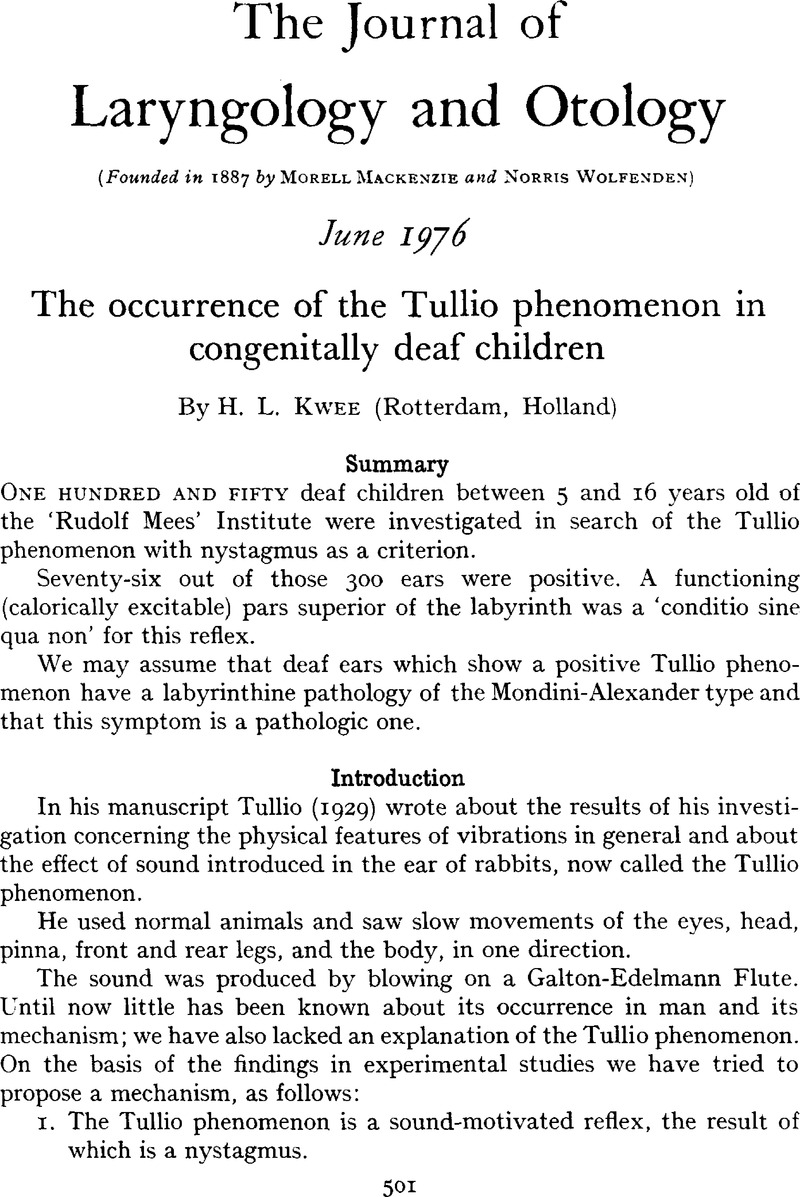Crossref Citations
This article has been cited by the following publications. This list is generated based on data provided by Crossref.
Erlich, Mark A.
and
Lawson, William
1980.
The Incidence and Significance of the Tullio Phenomenon in Man.
Otolaryngology–Head and Neck Surgery,
Vol. 88,
Issue. 5,
p.
630.
Bergstrom, LaVonne
1980.
Pendred's Syndrome with Atypical Features.
Annals of Otology, Rhinology & Laryngology,
Vol. 89,
Issue. 2,
p.
135.
Brandt, Thomas
and
Daroff, Robert B.
1980.
The multisensory physiological and pathological vertigo syndromes.
Annals of Neurology,
Vol. 7,
Issue. 3,
p.
195.
Oosterveld, W. J.
Polman, A. R.
and
Schoonheyt, J.
1982.
Vestibular Implications of Noise-Induced Hearing Loss.
British Journal of Audiology,
Vol. 16,
Issue. 4,
p.
227.
Pillsbury, Harold C.
and
Postma, Duncan S.
1983.
The Tullio Phenomenon, Fistula Test, and Hennebert’s Sign: Clinical Significance.
Otolaryngologic Clinics of North America,
Vol. 16,
Issue. 1,
p.
205.
Britton, B. Hill
1986.
Vestibular Responses to Pressure Variations: A Review.
Otolaryngology–Head and Neck Surgery,
Vol. 95,
Issue. 4,
p.
516.
Vogel, P.
Tackmann, W.
and
Schmidt, F.-J.
1986.
Observations on the Tullio phenomenon.
Journal of Neurology,
Vol. 233,
Issue. 3,
p.
136.
Fox, Eileen J.
Balkany, Thomas J.
and
Arenberg, Kaufman
1988.
The Tullio Phenomenon and Perilymph Fistula.
Otolaryngology–Head and Neck Surgery,
Vol. 98,
Issue. 1,
p.
88.
Ishizaki, Hisayoshi
Pyykko, Ilmari
Aalto, Heikki
and
Starck, Jukka
1991.
The Tullio Phenomenon in Patients with Meniere's Disease as Revealed with Posturography.
Acta Oto-Laryngologica,
Vol. 111,
Issue. sup481,
p.
593.
Ribaric, K.
Bleeker, J. D.
and
Wit, H. P.
1992.
Perception of Audio-frequency Vibrations by Profoundly Deaf Subjects after Fenestration of the Vestibular System.
Acta Oto-Laryngologica,
Vol. 112,
Issue. 1,
p.
45.
SAKELLARI, V.
and
SOAMES, R. W.
1996.
Auditory and visual interactions in postural stabilization.
Ergonomics,
Vol. 39,
Issue. 4,
p.
634.
Cremer, P.D.
Minor, L.B.
Carey, J.P.
and
Della Santina, C.C.
2000.
Eye movements in patients with superior canal dehiscence syndrome align with the abnormal canal.
Neurology,
Vol. 55,
Issue. 12,
p.
1833.
Watson, Shaun R. D.
Halmagyi, G. Michael
and
Colebatch, James G.
2000.
Vestibular hypersensitivity to sound (Tullio phenomenon).
Neurology,
Vol. 54,
Issue. 3,
p.
722.
Tanaka, Toshiaki
Kojima, Satoru
Takeda, Hidekatsu
Ino, Shuichi
and
Ifukube, Tohru
2001.
The influence of moving auditory stimuli on standing balance in healthy young adults and the elderly.
Ergonomics,
Vol. 44,
Issue. 15,
p.
1403.
Streubel, Phillip D. Cremer, John P, Sven-Olrik
2001.
Vestibular-Evoked Myogenic Potentials in the Diagnosis of Superior Canal Dehiscence Syndrome.
Acta Oto-Laryngologica,
Vol. 121,
Issue. 545,
p.
41.
Belden, Clifford J.
Weg, Noah
Minor, Lloyd B.
and
Zinreich, S. James
2003.
CT Evaluation of Bone Dehiscence of the Superior Semicircular Canal as a Cause of Sound- and/or Pressure-induced Vertigo.
Radiology,
Vol. 226,
Issue. 2,
p.
337.
Banerjee, A.
Whyte, A.
and
Atlas, M.D.
2005.
Superior canal dehiscence: review of a new condition.
Clinical Otolaryngology,
Vol. 30,
Issue. 1,
p.
9.
Hillman, Todd A.
Kertesz, Thomas R.
Hadley, Kevin
and
Shelton, Clough
2006.
Reversible Peripheral Vestibulopathy: The Treatment of Superior Canal Dehiscence.
Otolaryngology–Head and Neck Surgery,
Vol. 134,
Issue. 3,
p.
431.
Jackler, Robert K
Luxfor, William M.
and
House, William F.
2009.
Congenital malformations of the inner ear: A classification based on embryogenesis.
The Laryngoscope,
Vol. 97,
Issue. S40,
p.
2.
Vlastarakos, Petros V.
Proikas, Konstantinos
Tavoulari, Evangelia
Kikidis, Dimitrios
Maragoudakis, Paul
and
Nikolopoulos, Thomas P.
2009.
Efficacy assessment and complications of surgical management for superior semicircular canal dehiscence: a meta-analysis of published interventional studies.
European Archives of Oto-Rhino-Laryngology,
Vol. 266,
Issue. 2,
p.
177.



